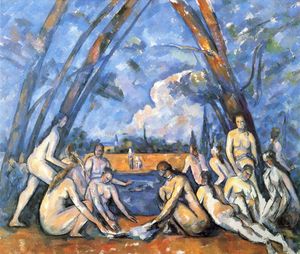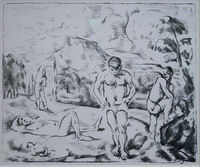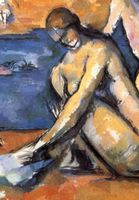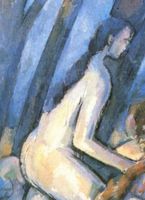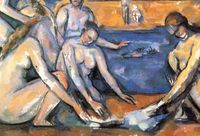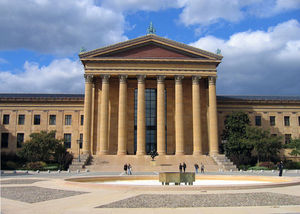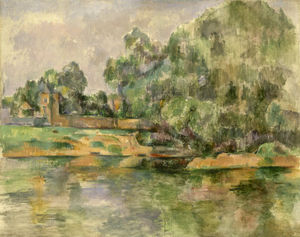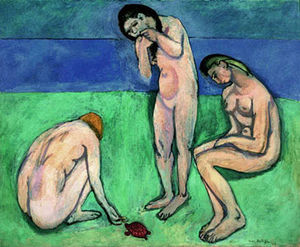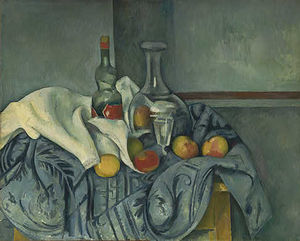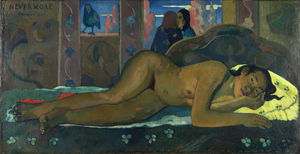The Large Bathers
- Date of Creation:
- 1906
- Height (cm):
- 250.80
- Length (cm):
- 210.50
- Medium:
- Oil
- Support:
- Canvas
- Subject:
- Fantasy
- Framed:
- No
- Art Movement:
- Post-Impressionism
- Created by:
- Current Location:
- Philadelphia, Pennsylvania
- Displayed at:
- Philadelphia Museum of Art
- Owner:
- Philadelphia Museum of Art
- The Large Bathers Page's Content
- Story / Theme
- Inspirations for the Work
- Analysis
- Critical Reception
- Related Paintings
- Artist
- Art Period
- Bibliography
The Large Bathers Story / Theme
Paul Cézanne created a series of bathers' paintings at the end of his career. The Large Bathers is so called because it was Cézanne's largest composition in the series, and it was the last to be produced.
When creating The Large Bathers Cézanne was attempting to produce a piece that would be timeless. The artist did not follow fashionable painting trends and felt no pressure to conform to nineteenth century methods.
The story that some critics have told describes the women in The Large Bathers as goddesses in the middle of nature. The trees are acting as their theater and the figures in the background are watching their actions. There is a distinct triangle shape that forces the viewer to focus on the lake and the small figures in the background. Despite the movement in the picture there is a sense of calm among the bathers. The viewer appears to take a voyeuristic peek into their private world.
Cézanne's scene, with its tranquil lake and church tower is not an exact representation of a real village. Cézanne created this image using his imagination and drawing from nature. The artist enjoyed painting landscapes and was inspired by nature but he wanted to understand it and paint more than what was on the surface.
Paul Cézanne prepared a number of practice paintings of figures before he started working on The Large Bathers. He experimented with how he wanted the figures to relate to each other and preparatory pieces show the bathers interacting with each other in various different ways.
Despite it's unpolished state The Large Bathers is considered a masterpiece of modern art and has appeared on television shows as one of the greatest compositions of all time.
The Large Bathers Inspirations for the Work
Paul Cézanne was influenced by a number of things when creating The Large Bathers. Firstly the artist had spent his early years in Paris at the Louvre museum, copying the paintings of the great masters. In the halls of one of the largest art museums in the world he saw the fantastic mystical paintings by artists such as Botticelli, Titian and Rubens. The God's, cherubs and mystical creatures of the Renaissance all inspired him to create scenes such as this one.
The calm waters in The Large Bathers and the slow movement of the figures all lend a mythical element to the work.
The nature and the small town in the background of the image were inspired by Aix-en-Provence. Paul Cézanne had grown up in this small town and even after moving to Paris he was attached to the countryside and his childhood surroundings. He spent many years traveling between the city and the countryside and Aix-en-Provence appeared in many of his works.
The Large Bathers Analysis
Composition:
The bather's are bordered by tress on either side of them. Each person is lent inward, making a triangle shape and framing the lake. Cézanne did this to keep his nudes in pre-determined spaces. For this painting there are at least twenty practice compositions of the different bathers and their varying poses.
The foreground of The Large Bathers is filled with figures and the nudes are mirroring each other. In the center the bather are knelt down with their arms leaning toward each other. The nudes looking toward the lagoon draw the viewer's attention to the people in the backdrop.
Color palette:
In The Large Bathers Cézanne has used light and dark blues, mixed with gold and bright white colors to create a sunny yet cloudy sky that appears to reach down to the small village. The trunks of the trees have been fashioned with golden honey and oak brown tones.
Each bather's skin color is complimented with a mane of chestnut brown hair and areas that have not been worked on, which signify where the light bounces off of their skin, are bright white. There are also shades of midnight blue and gray that are cleverly mixed into the skin. These shades help to give the skin depth and create contours, for example around the breasts. Additionally darker nut browns are used to shade the hips and backs, creating womanly forms.
Use of light:
Overall The Large Bathers is a well-lit piece. The bathers are illuminated from the right hand side of the painting, which obvious from the small amount of light that is hitting the bathers on the right. The bather who is crouched down has light hitting the elbow of her left arm and the underside of her thigh. However the nude on the left hand side of the painting, who is fully stretched out in front of the lake, is entirely illuminated by a white light. Both the bather's torso and her leg are luminescent, almost as though Cézanne has left his painting unfinished.
Mood, tone and emotion:
The tone of Paul Cézanne's The Large Bathers is mystical. However, this mystical tone is confused by the figure swimming in the lake. The calm waters have been disturbed by the ripples.
Brush stroke:
Paul Cézanne liked to use an obvious brush stroke that gave his work an unfinished quality and was not afraid to leave the trail of his working patterns on his paintings. In The Large Bathers Cézanne used thick layers of paint on his brush to create a haze of blue and green colors.
The Large Bathers Critical Reception
During life:
The general reaction to Paul Cézanne's Bathers series was exceptional but it was The Large Bathers that stood out to many people as the key work in the collection. The Large Bathers was praised for its wide spaces, well-formed figures (particularly those on the right hand side) and use of color. The swirling blue and white sky that stretched down to the lagoon was admired for its commanding use of space.
Paul Cézanne had spent his life studying the nude and exploring the relationships between people. The Large Bathers was the culminating piece of his life's work and the critical reception of it is often bound up in this fact. The Large Bathers is admired by critics the world over for the serene quality of the painting and the contrasts between the bathers and the man swimming in the lake.
After death:
The Large Bathers was first owned by the art dealer Ambroise Vollard in 1907, who bought it from Paul Cézanne's son (of the same name) after the artist's death. Vollard owned many of Cézanne's works and was for a long time his biggest art dealer. Vollard could see that The Large Bathers was going to be a timeless piece and considered it one of the defining pieces in his collection of Cézanne's work.
By the 1920s Paul Cézanne's The Large Bathers was being lent to galleries all over the world for a grateful audience to admire. When the artist and sculptor Henry Moore saw the painting in 1922 he was stunned by its composition and said, "If you asked me to name the ten most intense moments of visual emotion in my life, that would be one of them."
The Large Bathers was bought by the Philadelphia Museum of Art for $110,000 and it is the one of the most famous pieces of art work that Paul Cézanne produced and there are many art prints and posters available.
The Large Bathers Related Paintings
The Large Bathers Artist
Paul Cézanne was born to a wealthy family in Aix-en-Provence, France, and never had to worry about money whilst pursuing his painting ambitions. Although his father was not supportive of his chosen career he never stopped the flow of money to his beloved son.
Throughout his career Paul Cézanne only exhibited his work a few times due to the hostility of the general public and other artists. Yet, after his first solo exhibition in 1895 the artist garnered a great deal of positive feedback and followers. Later in his life the public were finally ready for Paul Cézanne's work.
Cézanne painted his series of bather's paintings during this popular period. He was a reclusive man who hid himself with his family in Aix-en-Provence and was unhappy when there was too great an influx of visitors to his family home. He created The Large Bathers shortly before he passed away in 1906.
The Large Bathers Art Period
Paul Cézanne did not wish to belong to an art movement and preferred to believe he was free of ties to any particular group. Early in his career, when he was painting with the Impressionist Camille Pissarro, he was influenced by his mentor's widened color palette. However he never chose to work fully in the Impressionist style.
Paul Cézanne is often described as the precursor for the Modernist, Cubist and Fauvist movements.
The Large Bathers Bibliography
For more information on Cezanne and his artworks please refer to the following recommended sources.
• Duchting, Hajo. Paul Cezanne. Taschen GmbH, 2009
• Loran, Erle. Cezanne's Composition: Analysis of His Form with Diagrams and Photographs of His Motifs. University of California Press, 2006
• Hoog, Michel & Stonehewer, Rosemary. Cezanne: The First Modern Painter. Thames & Hudson, 1994
• Rewald, John. Cezanne: A Biography. Harry N. Abrams, Inc. , 1996
• Simms, Matthew. Cezanne's Watercolors: Between Drawing and Painting. Yale University Press, 2008
• Smith, Paul. Interpreting Cezanne. Tate Publishing, 1996

